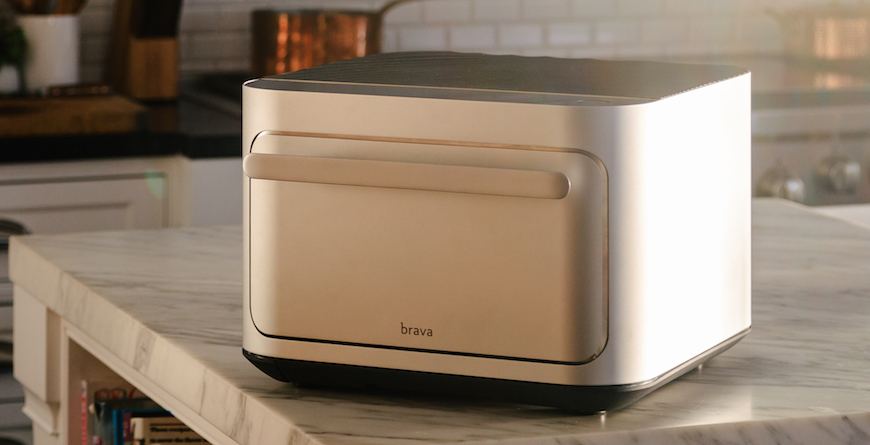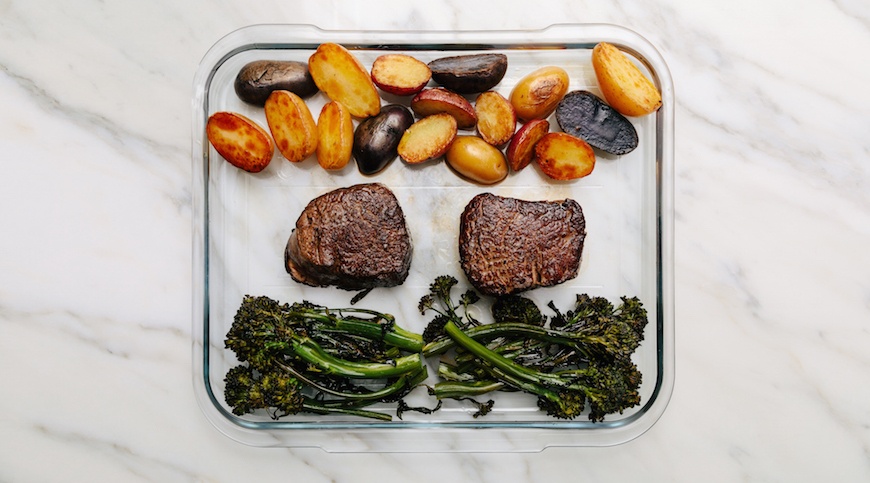I Tried Cooking With the Easy-Bake Oven of the Future—Here’s What Happened
The Easy-Bake Oven gave the illusion that cooking tasty food is a cinch. But, I learned when I grew up, "tasty" and "food" were both terms used extremely loosely here. Now, time and technology just might have made my childhood dreams of cooking—really cooking—with the push of a button a reality. Available for pre-order today is a new futuristic kitchen appliance that cooks entire meals using pure light technology (more on what that exactly means later).
"Brava is a technology company revolutionizing the way people cook at home," the press release that landed in my inbox read. "It uses an innovative new cooking technology that harnesses its energy source in the form of pure light, the first-of-its-kind in the consumer cooking space. Brava not only cooks your food to perfection, but does so rapidly. With the ability to go from 0°F to 500°F instantly without any preheat, Brava is the fastest oven in the world and the future of cooking."
While the pure light talk was a bit over my head, the speed definitely gave me pause. Like most people, I don't like waiting for my food to cook; when I'm hungry, I want to eat ASAP. Intrigued, I invited the Brava team to Well+Good HQ to try it first-hand before being released to the masses.

"The idea originally came from one of the founders, Dan Yue, six years ago," Brava CEO John Pleasants tells me when he comes to my office—with two chefs and two ovens (packed into industrial-strength rolling suitcases the team brought with them from San Francisco) in tow. "Dan was watching his mom run back and forth from the kitchen cooking the food and she wasn't able to be present with the family." Wanting to help her in a big way, Yue joked, wistfully, that he wanted to create a robot to do all the cooking for her. "Honestly, if the oven would just turn on, off, and adjust on its own, that would be a huge help," she said. Yue partnered up with his high-school buddy Thomas Cheng, a serial hardware entrepreneur, and they got to tinkering. It took six years and 11 evolutions, but they finally birthed the oven Yue and his mom dreamed up.

{{post.sponsorText}}
My first impression upon seeing the Brava: This is one sexy oven. (You know, as much as one can be.) Silver and sleek, it's a little bigger than the average size of a microwave, but we easily make room for it on the counter in our small office kitchen. On top, there's a touch-screen library of recipes (which is continually being added to) and a camera so you can see your food cooking inside—which connects to a Brava app so you can check in on your phone.

Two of the chefs on Brava's team, Travis Rea and Lindsay West, decide we should stop gawking and put the oven to the test by cooking salmon, tomatoes, and asparagus (all at the same time), steak and veggies (again simultaneously), and then stewed strawberries. They tell me one of the coolest things about the Brava is that it can sear meat perfectly. "We'll see," I think, recalling how any time I've heated meat in the microwave, it's ended up super dry and gross.
First, the salmon and vegetables: West finds the recipe on the touchscreen, which indicates which type of tray to use. (The Brava is compatible with glass and metal trays, and each requires different settings because the pure light technology affects them differently.) The trays are segmented into three different "zones," or sections, (shown in the photo below) and the recipe tells you exactly where to put what. Then, West pulls out something that looks similar to a USB cord. One end of it connects to inside the Brava, while the other end goes right in the meat, with the recipe indicating how far to insert it, so that it can monitor the temperature. Then, in goes the food.
They tell me one of the coolest things about the Brava is that it can sear meat perfectly. "We'll see," I think.
True to the press release's promise, the oven goes from 0 to full cooking temp real quick. Because it cooks with direct light energy, rather than by filling the space with heat like a regular oven (in science-speak, this is called convection), it also means it doesn't get the room all hot and the outside of the machine itself stays cool to the touch.
While we watch our fish and veggies cooking away by peeking at the camera on top, I ask Rea to break down the pure light technology for me. It sounds fancy—but is it complicated? "The energy from the lamp goes directly into the food," he says. "You can actually control how deeply it goes." That's why, he says, you can sear the top of meat without fully cooking the inside—you just have to indicate how you like your meat (medium rare, well done, etc.) on the touchscreen after choosing the recipe and it sets an algorithm into motion to get you what you want.
I know what you're thinking: But doesn't a microwave use light, too? How is this different? "A microwave uses, well, micro waves, to heat the water inside food so it starts to boil," Rea says. "That's why a lot of times, microwaves dry out your food. With the Brava, you're still heating the food from the outside, but you're doing it in a more efficient way using infrared light." Ah, so "pure light" = infrared, a word I've heard before.
"The primary thing that we’re doing that no one else is doing is the direct energy transfer, and that’s done using extremely efficient tools," Pleasants adds.

Rea wasn't lying about the efficiency: The food was ready in about half the time it would have taken in a traditional oven; our salmon lunch (complete with blistered cherry tomatoes and charred asparagus) took just 17 minutes to bake. And everything came out perfectly, no joke. And later, so did the steak, veggies, and stewed strawberries. Even though meat and vegetables require different cooking temperatures, they were still all able to be made at the same time. And yes, the sears really were perfect.
Over the most elaborate office lunch I've ever had (three full courses!), Pleasants tells me that Brava is more than just the ovens. They also have a marketplace of sustainably sourced foods and a meal plan program so that, if you choose, you can have your ingredients delivered to your doorstep. And again, everything is connected to the app, so you can scroll through recipes at work, send the one you want to the Brava (just like you do with articles on the Pocket app), and it'll be loaded on the machine when you get home.
"We want it to be a game-changing product the same way Peloton was for spin bikes and Sonos was for speakers." —John Pleasants, Brava CEO
Pleasants's brother-in-law is none other than Peloton CEO John Foley and Pleasants likens Brava to the bike, saying, "It's a direct-to-consumer model—we'll have one showroom in Palo Alto—and like Peloton, we don't want this to be a 'premium' product," he says. "We want it to be a game-changing product the same way Peloton was for spin bikes and Sonos was for speakers." The way Peloton brings a studio class to your living room, Brava wants to bring a restaurant to your kitchen counter. "We want to make life easier for people," Pleasants adds, "allowing them to be more connected to their family and friends and not stuck in the kitchen preparing the meal."
So how much will this non-premium product set you back? The two price points are $995 and $1,295, with the second option coming with more accessories and additional credits to the Brava marketplace and meal plan. There's also a financing option of $49 for 24 months. Despite all the Brava oven does, Pleasants says it isn't currently made to replace a standard oven; though after using it, I think it could replace the oven as long as you aren't cooking for more than four people, and to me that would justify the price. You really are able to cook an entire meal at just the press of a button.
Speaking of technology that will wow you, here's how tech is affecting the way we sleep and what you know about your microbiome.
Loading More Posts...